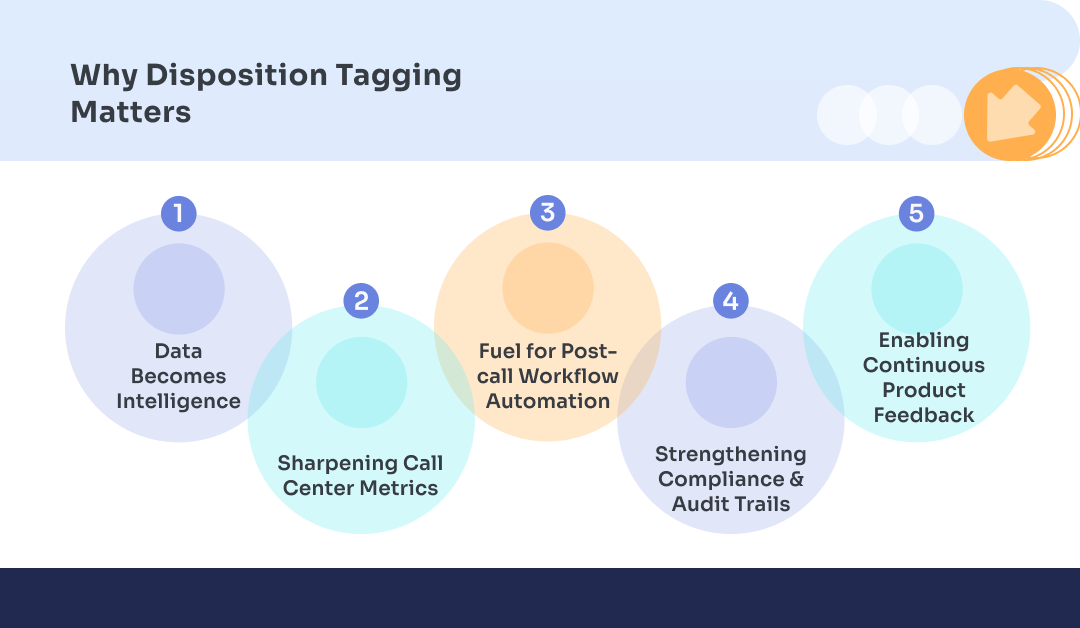Every phone conversation in your organization carries hidden value. Customers reveal pain points, prospects hint at buying signals, and users voice praise or frustration. But once the receiver rests in its cradle, or the soft-phone disconnects, what happens next? Too often, those rich details dissolve into digital nothingness. Enter call disposition, the unsung hero of post-call intelligence.
Call disposition offers important insights into the outcomes of phone calls, allowing businesses to evaluate agent performance, lead quality, and the overall effectiveness of their sales processes. By tracking call dispositions, companies can identify trends, refine their strategies, and make data-driven decisions that enhance customer interactions and boost sales.
By systematically tagging the outcome of every call, teams transform fleeting chats into durable data. That data powers smarter follow-ups, sharper coaching, and more predictable revenue. In the lines ahead, you’ll discover what call disposition is, why it matters, and how to harness it for tangible gains. You’ll also see how ScaleSupport helps companies embed best-practice disposition processes without breaking stride.
What Is Call Disposition?
Picture a shipping warehouse. After an order is packed, a worker applies a label that tells carriers exactly where the parcel should be delivered. Disposition tagging works similarly, but for conversations. Once a call ends, the agent assigns a label, often selected from a streamlined drop-down menu, that summarises the outcome in a single phrase. This tag becomes the address for the next action, guiding tasks through queues, calendars, and analytics dashboards.
Without that label, the call is effectively lost at sea. Supervisors have no quick way to tell whether the caller’s issue was solved, whether a lead was qualified, or whether another attempt is needed. Worse, the next agent who speaks to the same person might open with “How can I help you?”, forcing the customer to repeat the entire story. The label prevents that painful loop.
How Systems Handle Disposition Tags
Most modern dialers, contact-center platforms, and CRM call logging apps integrate dispositions into their wrap-up screens. The workflow typically looks like this:
- Agent finishes talking.
- A pop-up prompts the selection of a disposition code.
- Optional free-text notes provide colour.
- The system timestamps and stores both elements alongside the call recording.
- Automation engines read the disposition field and push data into tasks, emails, or CRM updates.
In outbound campaigns, dedicated outbound call tracking dashboards aggregate these tags in real-time, allowing campaign managers to tweak dial windows, messaging, or target lists on the fly.
The Standard Palette of Disposition Tags
Although each business customises its list, a core set of call disposition codes has emerged across industries:
| Disposition | Meaning | Example in Context | Next Logical Action |
| Completed | Objective met during the call | Support ticket closed | Close the ticket and send a satisfaction survey |
| Voicemail | Left a message | B2B outreach | Schedule a retry at a new time |
| No Answer | Rang out with no voicemail | Sales dial attempt | Re-queue after two hours |
| Follow-Up | Engagement, but unfinished task | Demo proposed | Book a follow-up meeting |
| Escalated | Needs a higher authority | Compliance query | Route to the legal team |
| Do Not Call | Opt-out request | Marketing call | Suppress the number organization-wide |
| Wrong Number | Reached the unintended party | Wrong listing | Correct database |
| Interested | The prospect shows a buying signal | Wants proposal | Email deck immediately |
Example Scenarios
Sales Example: A rep dials a dormant lead, discovers immediate interest, and chooses “Interested”. An automated email delivers a case study, while the CRM assigns a senior seller for a personalised demo.
Service Recovery: An irate customer calls about a delayed shipment. The frontline agent resolves the query but senses dissatisfaction, tagging “Escalated”. The loyalty team phones within the hour and offers a voucher, salvaging the relationship.
Why Call Disposition Tagging Matters

Accurate call dispositions are invaluable for running an efficient support or sales team. Here’s why call disposition should be a top priority:
Data Becomes Intelligence
A phone system by itself captures who called whom and for how long. Valuable, yes, but hardly strategic. When every entry also carries a disposition tag, that flat log morphs into a dynamic map of conversation journeys. Leaders see, at a glance, where callers stall, where they progress, and where hand-offs break. Research suggests that teams that rigorously track outcomes tend to have a higher first-call resolution rate than those that do not.
Sharpening Call Center Metrics
Most dashboards report volume, handle time, and wait time. Those numbers answer “how busy are we?,” not “how effective are we?”. By blending disposition data with traditional stats, you answer more profound questions:
- Which campaign produces the most “Interested” tags?
- Are certain product issues driving “Escalated” spikes this month?
- Do voicemail connection rates improve after hours?
With that knowledge, you can cut wasted dials, redeploy staff, or address emerging problems before they impact satisfaction scores.
Fuel for Post-call Workflow Automation
An email confirmation sent seconds after a “Completed” tag feels effortless to the customer and saves staff minutes per ticket. Multiply that by thousands of interactions, and you reclaim entire workdays. Similarly, automated alerts triggered by “Escalated” or “At-Risk” dispositions let retention specialists intervene before frustration boils over.
Strengthening Compliance & Audit Trails
Finance, healthcare, and utilities carry strict obligations to document interactions. When disposition tags capture these checkpoints, audit readiness improves overnight. Compliance officers filter the database for “Disclosure Given” or “Opt-Out” and provide regulators with a concise report within hours.
Enabling Continuous Product Feedback
If a sudden surge of “Escalated – Billing Error” tags appears after a pricing rollout, product managers pivot before a social-media storm erupts. The voice of the customer travels faster when outcome tagging surfaces emergent issues.
Common Mistakes Teams Make with Dispositions
Given the immense value of call dispositions, what causes so many teams to drop the ball? Here are a few frequent mishaps:
Copy-Pasting Someone Else’s List
- A template pulled from the internet rarely matches your workflow. Important stages go untracked, while irrelevant ones clog reports.
Treating Disposition as Admin Overhead
- When speed trumps accuracy, agents click the first option and move on. Insight quality craters.
Overcomplicating Early, Simplifying Late
- Sixty granular codes overwhelm agents; five vague ones starve analysts. Build gradually and validate usefulness.
Ignoring Human Nuance
- A code cannot tell the whole story. Encourage concise context notes – promised dates, emotional cues, or names.
Letting the List Age Unattended
- Product lines evolve, yet code libraries remain frozen. Schedule quarterly reviews and sunset obsolete tags.
Failing to Close the Loop
- Data sits in a dashboard, but nobody owns it. Assign clear stakeholders for each outcome group.
Training Once, Forgetting Forever
- Like language learning, accuracy decays without practice. Refresher modules keep definitions sharp.
No Integration with Performance Reviews
- If evaluations ignore tagging quality, staff rightly assume it does not matter. Include a small accuracy score in quarterly reviews.
Proven Disposition Strategies to Empower Your Team
Want your team to get the most out of call disposition? It’s not enough to simply assign call outcomes. Success lies in how systematically you implement, train, and analyze your disposition process. Here are tested strategies that help you standardize call tagging, reduce manual errors, and convert raw call data into meaningful business insights.
1. Create Specific and Actionable Disposition Categories
One of the most common pitfalls in call tagging is the use of vague or overly broad labels like “Call Completed” or “Other.” While these may simplify the tagging process on the surface, they fail to provide clarity about what really happened on the call or what needs to happen next.
Instead, build a list of call outcome categories that are both specific and actionable. Examples include:
- Lead Qualified: Awaiting Proposal
- Demo Completed: Follow-Up in 3 Days
- Support Escalated: Technical Team Notified
- Voicemail Left: Reattempt Scheduled
These kinds of labels not only capture the intent behind the conversation but also serve as triggers for follow-up actions. The more precise your categories, the easier it becomes for downstream teams to respond appropriately.
Pro tip: Segment your disposition codes by team or function. Sales, support, and billing departments often require different tagging systems tailored to their unique workflows.
2. Set Clear Coding Guidelines Across the Organization
Even with well-designed codes, misunderstandings can arise if agents aren’t aligned on when and how to use each tag. That’s why a strong disposition strategy requires written guidelines.
Document rules, examples, and common misuses for each tag. For instance:
- Do use “Lead Qualified” if the customer matches the ICP and expressed interest
- Don’t use “Follow-Up Required” when the customer clearly said they’re not interested
Offer a one-pager or quick-reference guide that agents can refer to during live calls or wrap-ups. Ensure new hires are trained during onboarding, and periodically retrain existing agents to avoid knowledge decay.
Well-defined guidelines remove ambiguity, reduce tagging errors, and create a consistent standard for call outcome recording across the team.
3. Embed Definitions and Context Directly into Software
To ensure consistent usage of tags, integrate brief definitions or usage examples directly into your CRM call logging interface or dialer software. These tooltips or inline descriptions act as reminders for agents during live operations.
For instance, hovering over “Escalated – Urgent” might reveal:
“Select when the customer has an unresolved issue that requires immediate escalation to Tier 2 or management.”
Doing so reduces reliance on memory, especially for new or part-time agents, and helps eliminate accidental misuse of tags, making your call center metrics more accurate and reliable.
If your platform allows, use conditional logic to display tags relevant only to specific teams or call types, simplifying the interface and improving speed.
4. Make Disposition Tagging Mandatory for All Calls
A consistent disposition process starts with 100% compliance. That means every call, no matter how short or inconclusive, must be tagged before it’s marked complete.
Why? Because even non-events carry value. A missed call or wrong number might not be exciting, but tagging it correctly (“No Answer,” “Wrong Contact Info”) ensures your outbound call tracking stays clean and informative. It also helps you avoid follow-up mistakes, like repeatedly calling someone who asked not to be contacted.
Configure your systems so that agents cannot close a call or move to the next one without first selecting an appropriate disposition. This small enforcement step prevents data loss and builds trust in your call analytics.
5. Automate Post-Call Workflows Based on Tag Outcome
Call tagging shouldn’t end with classification – it should lead to action. The best systems use disposition codes as the starting point for post-call workflow automation.
When a call is tagged, your CRM or helpdesk software can automatically:
- Assign a task for follow-up calls
- Send confirmation emails to customers
- Notify managers of escalated cases
- Trigger feedback forms or surveys
- Update the lead stages in your sales pipeline
This automation not only saves your team manual effort but also ensures that no opportunity or support ticket gets forgotten. When disposition codes double as workflow triggers, your team becomes faster, more reliable, and more proactive.
Automation also helps align marketing, sales, and support teams. For example, a sales call marked as “Demo Completed – Awaiting Proposal” can prompt marketing to share a relevant case study, enhancing the lead’s journey without the agent lifting a finger.
6. Regularly Review and Optimise Based on Disposition Analytics
Once your disposition process is in place, the real work begins: analyzing and improving based on the data.
Run regular reports to track:
- Most frequently used disposition codes
- Escalation trends by product or team
- Conversion rates tied to specific call outcomes
- Follow-up completion rates by disposition type
- Call resolution patterns by day/time/agent
Armed with these insights, you can:
- Refine call scripts: Notice a high number of “Not Interested” tags? Review and optimise your pitch.
- Improve staffing: Spike in “Voicemail Left” calls in the morning? Adjust call timing for better contact rates.
- Identify training needs: Agents with a high percentage of “Escalated” tags may need refresher training.
- Enhance follow-up protocols: Low conversion from “Lead Qualified” to “Sale Closed”? Rework your nurturing flow.
This is where disposition turns into a decision-making asset. When data is mined regularly and shared with the right people, your entire call process becomes smarter and more customer-centric.
How ScaleSupport Maximizes Disposition Efficiency
As a leading provider of white glove customer support, ScaleSupport lives and breathes call efficiency. Our highly trained agents don’t just understand proper call coding; we’ve developed rock-solid strategies to maximize value from dispositions.
Here’s how we make the most of call categorization for every client:
CRM Mastery
Our agents seamlessly integrate detailed disposition logs into major CRM platforms. This enhances organization, reporting, and automatic post-call actions.
Quality Monitoring
With regular call sampling, we provide coaching and feedback to hone precision coding skills. Accurate designations are instilled into daily operations.
Data Analysis
ScaleSupport examines call data to gain actionable, macro-level insight. We refine processes, boost sales opportunities, reduce redundancies, and make clients more profitable.
Our proven methodology combines the right software, disciplined training, and overarching accountability to achieve call disposition excellence.
Conclusion
Smart organizations treat call disposition as the connective tissue that binds conversation, action, and insight. When every exchange ends with a clear, accurate tag, the next move becomes obvious, delays shrink, and customers feel the difference. Data quality improves, coaching gains focus, and executives steer strategy with sharper instruments.
We’ve explored the nuts and bolts of disposition frameworks, common traps to avoid, and tactical plays that elevate performance. We’ve also seen how ScaleSupport embeds best practices quickly, sustains accuracy at scale, and transforms raw tags into business-changing intelligence.
Your next step is simple: pull a random sample of yesterday’s calls and inspect the tags. Do they reveal the true story? If not, refresh the code list, empower your agents, and make sure actions align with outcomes. Momentum will follow.
Reach out to ScaleSupport for a discovery chat. Turning conversations into growth is easier when seasoned process architects already hold the blueprints. Either way, commit to clear outcomes, disciplined follow-through, and a culture that values data-driven action. Start the journey now. Schedule a free consultation and keep learning, refining, and sharing wins.

Dianne has extensive experience as a Content Writer, she creates engaging content that captivates readers and ranks well online. She stays on top of industry trends to keep her work fresh and impactful. She has a talent for turning complex ideas into relatable stories. When she’s not writing, you’ll probably find her with a crochet hook in hand or working on a fun craft project. She loves bringing creativity to life, whether it’s through words or handmade creations.






